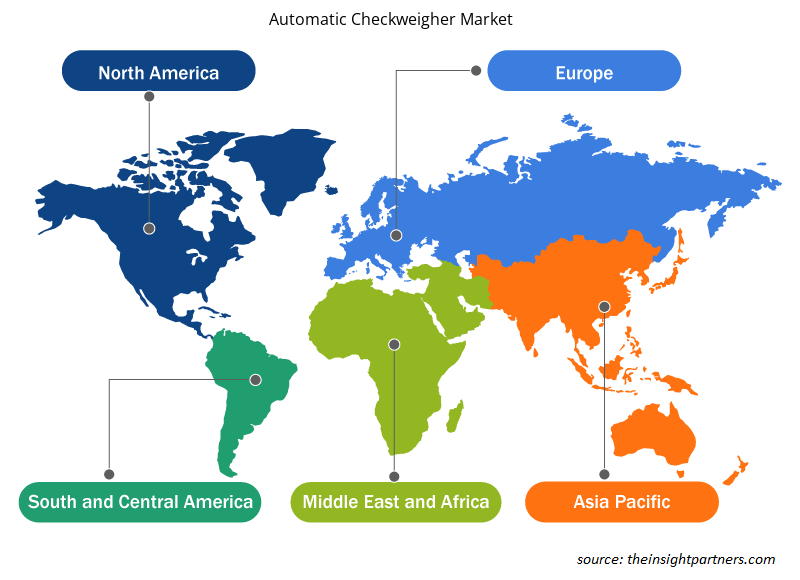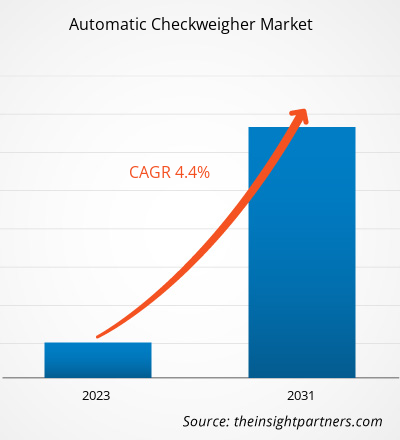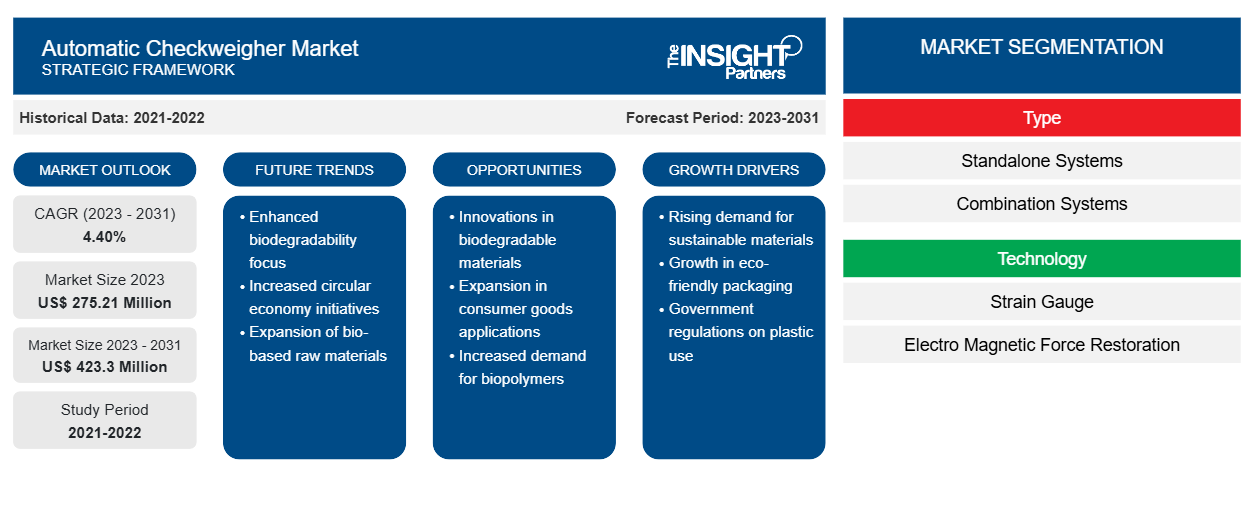Se proyecta que el tamaño del mercado de las controladoras de peso automáticas alcance los 423,3 millones de dólares estadounidenses en 2031, frente a los 275,21 millones de dólares estadounidenses en 2023. Se espera que el mercado registre una tasa compuesta anual de crecimiento del 4,40 % entre 2023 y 2031. Las estrictas regulaciones gubernamentales para el control de calidad de los productos han obligado a los fabricantes a instalar las controladoras de peso automáticas en las plantas de producción. Además, los numerosos fabricantes de controladoras de peso automáticas ofrecen productos de calidad y eficientes, lo que respalda el crecimiento del mercado.
Análisis del mercado de las controladoras de peso automáticas
La creciente tendencia de las fábricas inteligentes en todas las industrias es uno de los factores que impulsa la demanda de las controladoras de peso automáticas. Muchos fabricantes de controladoras de peso automáticas integran sistemas de transporte para proporcionar una mayor eficiencia operativa. Además, algunas de las empresas de fabricación también están integrando controladoras de peso automotrices con un sistema robótico de envasado inteligente , que verifica la cantidad de productos envasados inmediatamente después del proceso de envasado. Estos avances han ayudado a que el mercado de las controladoras de peso automáticas crezca notablemente. Además, las regulaciones de las fuertes multas por parte de la Administración de Alimentos y Medicamentos de los EE. UU. a las empresas de fabricación en los EE. UU. es otro factor que está impulsando el crecimiento del mercado de la industria de las controladoras de peso automáticas.
Descripción general del mercado de controladoras de peso automáticas
Los países desarrollados, como Estados Unidos y Alemania, entre otros, fueron algunos de los primeros en adoptar la báscula de control automática debido a las estrictas leyes de protección al consumidor. Industrias como la farmacéutica, la cosmética y el cuidado personal son algunas de las industrias más destacadas en los países desarrollados. En las primeras etapas, la demanda de la báscula de control automática era alta en la industria farmacéutica; sin embargo, a medida que comenzó a producirse el crecimiento industrial en los países en desarrollo, aumentó la demanda de báscula de control automática en la industria de alimentos y bebidas.
En función del tipo, se prevé que los sistemas combinados dominen durante el período de pronóstico. El sistema combinado viene con una variedad de sistemas integrados, como tecnología de rayos X y tecnología de detección de metales, entre otros. Esto ayuda a la industria de alimentos y bebidas a reducir la cantidad de productos defectuosos que llegan al consumidor. Esto ha ayudado a muchas empresas a mantener y mejorar su imagen de marca en su industria en particular.
Personalice este informe según sus necesidades
Obtendrá personalización en cualquier informe, sin cargo, incluidas partes de este informe o análisis a nivel de país, paquete de datos de Excel, así como también grandes ofertas y descuentos para empresas emergentes y universidades.
-
Obtenga las principales tendencias clave del mercado de este informe.Esta muestra GRATUITA incluirá análisis de datos, desde tendencias del mercado hasta estimaciones y pronósticos.
Factores impulsores y oportunidades del mercado de las controladoras de peso automáticas
Mayor adopción por parte de diversas industrias de uso final
El crecimiento continuo de la industria farmacéutica, química y de alimentos y bebidas ha impulsado el crecimiento del mercado de las controladoras de peso automáticas. El aumento de la producción diaria en las industrias mencionadas anteriormente ha aumentado la necesidad de sistemas de controladoras de peso automáticas grandes o múltiples. Las controladoras de peso automáticas ayudan a la fabricación a reducir los errores causados por la intervención humana y también ayudan a reducir el costo operativo de la mano de obra para pesar el producto envasado. Esto ha ayudado a casi todas las empresas de las industrias farmacéutica, alimentaria y de bebidas a fortalecer su imagen de marca en las respectivas industrias.
Fuerte crecimiento de la industria de alimentos y bebidas
El consumo de alimentos y bebidas está creciendo significativamente debido al aumento de la población y de los ingresos disponibles. Según el estudio, en 2021, la categoría de bebidas envasadas aumentó un 16,5% con respecto a 2020, y se prevé que esta tendencia crezca en los próximos años. Además, según los datos proporcionados por Nestlé, una marca destacada en la industria de alimentos y bebidas, la empresa fue testigo de un crecimiento orgánico del 8% en todo el mundo. Además, las ventas de Procter & Gamble en 2020 fueron de 76.100 millones de dólares, que aumentaron a 82.000 millones de dólares en 2022. Por tanto, las estadísticas anteriores muestran el crecimiento continuo de la industria de alimentos y bebidas. Se estima que este crecimiento constante continuará durante el período de previsión, lo que en última instancia impulsará la demanda de la controladora de peso automática en los próximos años.
Análisis de segmentación del informe de mercado de controladoras de peso automáticas
Los segmentos clave que contribuyeron a la derivación del análisis del mercado de controladoras de peso automáticas son el tipo, la causa, el tipo de trastorno, la categoría y el usuario final.
- Según el tipo, el mercado de controladoras de peso automáticas se divide en sistemas independientes y sistemas combinados. El segmento de sistemas combinados tuvo una mayor participación de mercado en 2023.
- Por tecnología, el mercado está segmentado en recuperación de fuerza electromagnética (EMFR) con galgas extensométricas. El segmento de galgas extensométricas tuvo la mayor participación del mercado en 2023.
- En cuanto a la industria de consumo final, el mercado se divide en alimentos y bebidas, productos farmacéuticos, productos de consumo, cosméticos y cuidado personal, entre otros. El segmento de alimentos y bebidas dominó el mercado en 2023.
Análisis de la cuota de mercado de las controladoras automáticas de peso por geografía
El alcance geográfico del informe del mercado de controladoras de peso automáticas se divide principalmente en cinco regiones: América del Norte, Asia Pacífico, Europa, Medio Oriente y África, y América del Sur/América del Sur y Central.
La región de Asia Pacífico representó la mayor participación de mercado durante el período de pronóstico. El mercado de encimeras de cocina de Asia Pacífico se clasifica además en Australia, China, India, Japón, Corea del Sur y el resto de Asia Pacífico. Uno de los principales factores detrás del crecimiento de las controladoras de peso automáticas es la alta demanda de la industria de alimentos y bebidas debido al aumento de la población. Según los datos publicados por el gobierno indio en 2023, el mercado indio de procesamiento de alimentos alcanzó los 305 mil millones de dólares en 2022 y se proyecta que alcance los 550 mil millones de dólares en 2028. Además, la entrada continua de nuevas empresas de alimentos y bebidas es otro factor que impulsa el mercado de las controladoras de peso automáticas en la región.
Perspectivas regionales del mercado de controladoras de peso automáticas
Los analistas de Insight Partners explicaron en detalle las tendencias y los factores regionales que influyen en el mercado de las controladoras de peso automáticas durante el período de pronóstico. Esta sección también analiza los segmentos y la geografía del mercado de las controladoras de peso automáticas en América del Norte, Europa, Asia Pacífico, Oriente Medio y África, y América del Sur y Central.

- Obtenga datos regionales específicos para el mercado de controladoras de peso automáticas
Alcance del informe de mercado de controladoras de peso automáticas
| Atributo del informe | Detalles |
|---|---|
| Tamaño del mercado en 2023 | US$ 275,21 millones |
| Tamaño del mercado en 2031 | US$ 423,3 millones |
| CAGR global (2023 - 2031) | 4,40% |
| Datos históricos | 2021-2022 |
| Período de pronóstico | 2023-2031 |
| Segmentos cubiertos |
Por tipo
|
| Regiones y países cubiertos |
América del norte
|
| Líderes del mercado y perfiles de empresas clave |
|
Densidad de actores del mercado de controladores de peso automáticos: comprensión de su impacto en la dinámica empresarial
El mercado de las controladoras de peso automáticas está creciendo rápidamente, impulsado por la creciente demanda de los usuarios finales debido a factores como la evolución de las preferencias de los consumidores, los avances tecnológicos y una mayor conciencia de los beneficios del producto. A medida que aumenta la demanda, las empresas amplían sus ofertas, innovan para satisfacer las necesidades de los consumidores y aprovechan las tendencias emergentes, lo que impulsa aún más el crecimiento del mercado.
La densidad de actores del mercado se refiere a la distribución de las empresas o firmas que operan dentro de un mercado o industria en particular. Indica cuántos competidores (actores del mercado) están presentes en un espacio de mercado determinado en relación con su tamaño o valor total de mercado.
Las principales empresas que operan en el mercado de controladoras de peso automáticas son:
- Minebea Intec GmbH
- Corporación Anritsu
- Cardenal
- Obras Espera
- Soluciones de proceso Hardy, Inc.
- Mettler-Toledo Internacional Inc.
Descargo de responsabilidad : Las empresas enumeradas anteriormente no están clasificadas en ningún orden particular.

- Obtenga una descripción general de los principales actores clave del mercado de controladoras de peso automáticas
Noticias y desarrollos recientes del mercado de las controladoras de peso automáticas
El mercado de las controladoras de peso automáticas se evalúa mediante la recopilación de datos cualitativos y cuantitativos posteriores a la investigación primaria y secundaria, que incluye publicaciones corporativas importantes, datos de asociaciones y bases de datos. A continuación, se incluye una lista de los avances en el mercado de las controladoras de peso automáticas y las estrategias:
- Mettler-Toledo Product Inspection lanzó una nueva solución combinada de seguimiento y trazabilidad y control de peso dirigida a fabricantes pequeños y medianos de las industrias farmacéutica y cosmética. El sistema CT33 de Mettler-Toledo ofrece a los operadores una integración perfecta entre las capacidades de marcado y verificación, serialización y pesaje de precisión, lo que les ayuda a lograr el cumplimiento, una mejor protección de la marca, control de calidad y trazabilidad de la cadena de suministro. (Fuente: Mettler-Toledo, comunicado de prensa/sitio web de la empresa/boletín informativo, 2022)
- Fortress Technology Europe siguió ampliando su cartera de maquinaria fácil de usar y que ahorra residuos con la incorporación de una nueva controladora de peso en línea para el procesamiento de alimentos. Diseñada para líneas de procesamiento automatizadas de ingredientes crudos, el lanzamiento de la controladora de peso en línea higiénica Raptor en PPMA 2023 (Stand B01) ofrece a los fabricantes de panadería, carne, mariscos y alimentos preparados un sistema de pesaje eficiente y en movimiento que se conecta al equipo de control de porciones anterior. (Fuente: Fortress Technology, comunicado de prensa/sitio web de la empresa/boletín informativo, 2023)
Informe de mercado sobre control automático de peso: cobertura y resultados
El informe “Tamaño y pronóstico del mercado de controladoras de peso automáticas (2021-2031)” proporciona un análisis detallado del mercado que cubre las siguientes áreas:
- Tamaño del mercado y pronóstico a nivel global, regional y nacional para todos los segmentos clave del mercado cubiertos bajo el alcance
- Dinámica del mercado, como impulsores, restricciones y oportunidades clave
- Principales tendencias futuras
- Análisis detallado de las cinco fuerzas de Porter y PEST y FODA
- Análisis del mercado global y regional que cubre las tendencias clave del mercado, los principales actores, las regulaciones y los desarrollos recientes del mercado.
- Análisis del panorama de la industria y de la competencia que abarca la concentración del mercado, el análisis de mapas de calor, los actores destacados y los desarrollos recientes
- Perfiles detallados de empresas
- Análisis histórico (2 años), año base, pronóstico (7 años) con CAGR
- Análisis PEST y FODA
- Tamaño del mercado, valor/volumen: global, regional y nacional
- Industria y panorama competitivo
- Conjunto de datos de Excel
Informes recientes
Testimonios
Razón para comprar
- Toma de decisiones informada
- Comprensión de la dinámica del mercado
- Análisis competitivo
- Información sobre clientes
- Pronósticos del mercado
- Mitigación de riesgos
- Planificación estratégica
- Justificación de la inversión
- Identificación de mercados emergentes
- Mejora de las estrategias de marketing
- Impulso de la eficiencia operativa
- Alineación con las tendencias regulatorias























 Obtenga una muestra gratuita para - Mercado de controladoras de peso automáticas
Obtenga una muestra gratuita para - Mercado de controladoras de peso automáticas